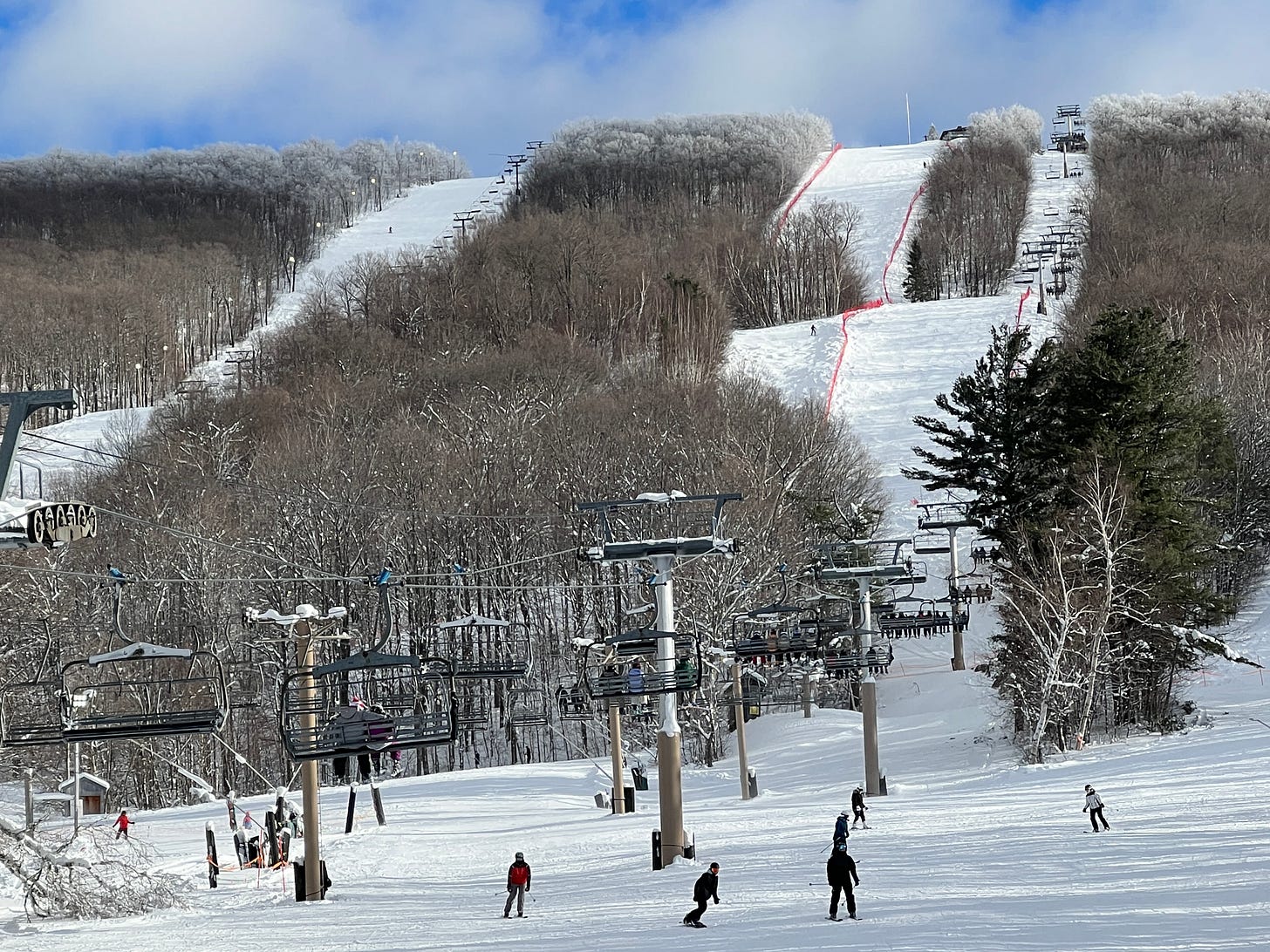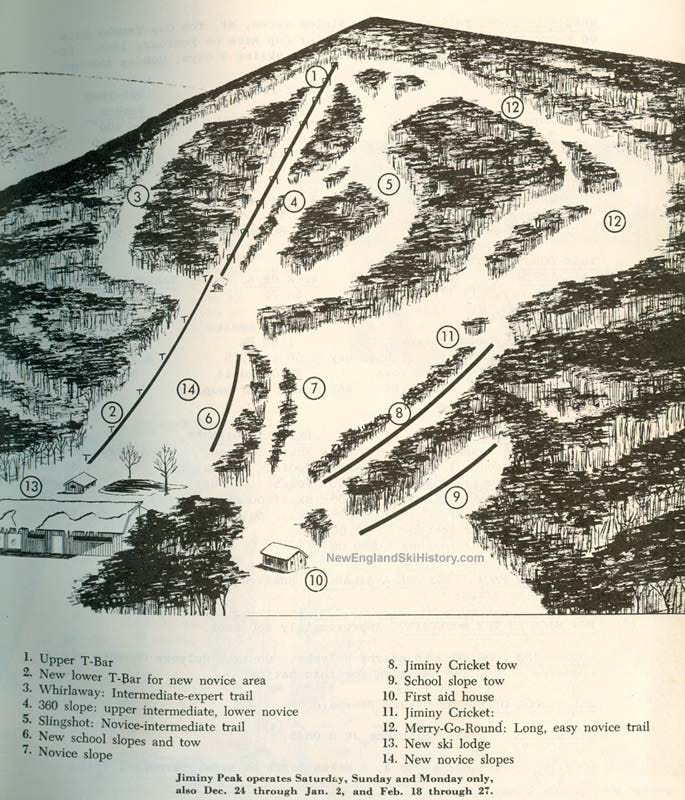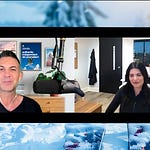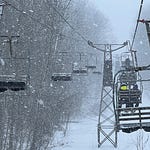Who
Tyler Fairbank, General Manager of Jiminy Peak, Massachusetts and CEO of Fairbank Group

Recorded on
February 10, 2025 and March 7, 2025
About Fairbank Group
From their website:
The Fairbank Group is driven to build things to last – not only our businesses but the relationships and partnerships that stand behind them. Since 2008, we have been expanding our eclectic portfolio of businesses. This portfolio includes three resorts—Jiminy Peak Mountain Resort, Cranmore Mountain Resort, and Bromley Mountain Ski Resort—and real estate development at all three resorts, in addition to a renewable energy development company, EOS Ventures, and a technology company, Snowgun Technology.
About Jiminy Peak
Click here for a mountain stats overview
Owned by: Fairbank Group, which also owns Cranmore and operates Bromley (see breakdowns below)
Located in: Hancock, Massachusetts
Year founded: 1948
Pass affiliations:
Ikon Pass: 2 days, with blackouts
Uphill New England
Closest neighboring ski areas: Bousquet (:27), Catamount (:49), Butternut (:51), Otis Ridge (:54), Berkshire East (:58), Willard (1:02)
Base elevation: 1,230 feet
Summit elevation: 2,380 feet
Vertical drop: 1,150 feet
Skiable acres: 167.4
Average annual snowfall: 100 inches
Trail count: 42
Lift count: 9 (1 six-pack, 2 fixed-grip quads, 3 triples, 1 double, 2 carpets – view Lift Blog’s inventory of Jiminy Peak’s lift fleet)
About Cranmore
Click here for a mountain stats overview
Owned by: The Fairbank Group
Located in: North Conway, New Hampshire
Year founded: 1937
Pass affiliations:
Ikon Pass: 2 days, with blackouts
Uphill New England
Closest neighboring ski areas: Attitash (:16), Black Mountain (:18), King Pine (:28), Wildcat (:28), Pleasant Mountain (:33), Bretton Woods (:42)
Base elevation: 800 feet
Summit elevation: 2,000 feet
Vertical drop: 1,200 feet
Skiable Acres: 170
Average annual snowfall: 80 inches
Trail count: 56 (15 most difficult, 25 intermediate, 16 easier)
Lift count: 7 (1 high-speed quad, 1 fixed-grip quad, 2 triples, 1 double, 2 carpets – view Lift Blog’s inventory of Cranmore’s lift fleet)
About Bromley
Click here for a mountain stats overview
Owned by: The estate of Joseph O'Donnell
Operated by: The Fairbank Group
Pass affiliations: Uphill New England
Located in: Peru, Vermont
Closest neighboring ski areas: Magic Mountain (14 minutes), Stratton (19 minutes)
Base elevation: 1,950 feet
Summit elevation: 3,284 feet
Vertical drop: 1,334 feet
Skiable Acres: 300
Average annual snowfall: 145 inches
Trail count: 47 (31% black, 37% intermediate, 32% beginner)
Lift count: 9 (1 high-speed quad, 1 fixed-grip quad, 4 doubles, 1 T-bar, 2 carpets - view Lift Blog’s of inventory of Bromley’s lift fleet)
Why I interviewed him
I don’t particularly enjoy riding six-passenger chairlifts. Too many people, up to five of whom are not me. Lacking a competent queue-management squad, chairs rise in loads of twos and threes above swarming lift mazes. If you’re skiing the West, lowering the bar is practically an act of war. It’s all so tedious. Given the option – Hunter, Winter Park, Camelback – I’ll hop the parallel two-seater just to avoid the drama.
I don’t like six-packs, but I sure am impressed by them. Sixers are the chairlift equivalent of a two-story Escalade, or a house with its own private Taco Bell, or a 14-lane expressway. Like damn there’s some cash floating around this joint.
Sixers are common these days: America is home to 107 of them. But that wasn’t always so. Thirty-two of these lifts came online in just the past three years. Boyne Mountain, Michigan built the first American six-pack in 1992, and for three years, it was the only such lift in the nation (and don’t think they didn’t spend every second reminding us of it). The next sixer rose at Stratton, in 1995, but 18 of the next 19 were built in the West. In 2000, Jiminy Peak demolished a Riblet double and dropped the Berkshire Express in its place.
For 26 years, Jiminy Peak has owned the only sixer in the State of Massachusetts (Wachusett will build the second this summer). Even as they multiply, the six-pack remains a potent small-mountain status symbol: Vail owns 31 or them, Alterra 30. Only 10 independents spin one. Sixers are expensive to build, expensive to maintain, difficult to manage. To build such a machine is to declare: we are different, we can handle this, this belongs here and so does your money.
Sixty years ago, Jiminy Peak was a rump among a hundred poking out of the Berkshires. It would have been impossible to tell, in 1965, which among these many would succeed. Plenty of good ski areas failed since. Jiminy is among the last mountains standing, a survival-of-the-fittest tale punctuated, at the turn of the century, by the erecting of a super lift that was impossible to look away from. That neighboring Brodie, taller and equal-ish in size to Jiminy, shuttered permanently two years later, after a 62-year run as a New England staple, was probably not a coincidence (yes, I’m aware that the Fairbanks themselves bought and closed Brodie). Jiminy had planted its 2,800-skier-per-hour flag on the block, and everyone noticed and no one could compete.
The Berkshire Express is not the only reason Jiminy Peak thrives in a 21st century New England ski scene defined by big companies, big passes, and big crowds. But it’s the best single emblem of a keep-moving philosophy that, over many decades, transformed a rust-bucket ski area into a glimmering ski resort. That meant snowmaking before snowmaking was cool, building places to stay on the mountain in a region of day-drivers, propping a wind turbine on the ridge to offset dependence on the energy grid.
Non-ski media are determined to describe America’s lift-served skiing evolution in terms of climate change, pointing to the shrinking number of ski areas since the era when any farmer with a backyard haystack and a spare tractor engine could run skiers uphill for a nickel. But this is a lazy narrative (America offers a lot more skiing now than it did 30 years ago). Most American ski areas – perhaps none – have failed explicitly because of climate change. At least not yet. Most failed because running a ski area is hard and most people are bad at it. Jiminy, once surrounded by competitors, now stands alone. Why? That’s what the world needs to understand.
What we talked about
The impact of Cranmore’s new Fairbank Lodge; analyzing Jiminy’s village-building past to consider Cranmore’s future; Bromley post-Joe O’Donnell (RIP); Joe’s legacy – “just an incredible person, great guy”; taking the long view; growing up at Jiminy Peak in the wild 1970s; Brian Fairbank’s legacy building Jiminy Peak – with him, “anything is possible”; how Tyler ended up leading the company when he at one time had “no intention of coming back into the ski business”; growing Fairbank Group around Jiminy; surviving and recovering from a stroke – “I had this thing growing in me my entire life that I didn’t realize”; carrying on the family legacy; why Jiminy and Cranmore joined the Ikon Pass as two-day partners, and whether either mountain could join as full partners; why Bromley didn’t join Ikon; the importance of New York City to Jiminy Peak and Boston to Cranmore; why the ski areas won’t be direct-to-lift with Ikon right away; are the Fairbank resorts for sale?; would Fairbank buy more?; the competitive advantage of on-mountain lodging; potential Jiminy lift upgrades; why the Berkshire Express sixer doesn’t need an upgrade of the sort that Cranmore and Bromley’s high-speed quads received; why Jiminy runs a fixed-grip triple parallel to its high-speed six; where the mountain’s next high-speed lift could run; and Jiminy Peak expansion potential.
What I got wrong
I said that I didn’t know which year Jiminy Peak installed their wind turbine – it was 2007. Berkshire East built its machine in 2010 and activated it in 2011.
When we recorded the Ikon addendum, Cranmore and Jiminy Peak had not yet offered any sort of Ikon Pass discount to their passholders, but Tyler promised details were coming. Passholders can now find offers for a discounted ($229) three-day Ikon Session pass on either ski area’s website.
Why now was a good time for this interview
For all the Fairbanks’ vision in growing Jiminy from tumbleweed into redwood, sprinting ahead on snowmaking and chairlifts and energy, the company has been slow to acknowledge the largest shift in the consumer-to-resort pipeline this century: the shift to multi-mountain passes. Even their own three mountains share just one day each for sister resort passholders.
That’s not the same thing as saying they’ve been wrong to sit and wait. But it’s interesting. Why has this company that’s been so far ahead for so long been so reluctant to take part in what looks to be a permanent re-ordering of the industry? And why have they continued to succeed in spite of this no-thanks posture?
Or so my thinking went when Tyler and I scheduled this podcast a couple of months ago. Then Jiminy, along with sister resort Cranmore, joined the Ikon Pass. Yes, just as a two-day partner in what Alterra is labeling a “bonus” tier, and only on the full Ikon Pass, and with blackout dates. But let’s be clear about this: Jiminy Peak and Cranmore joined the Ikon Pass.
Unfortunately (or perhaps fortunately), for me and my Pangea-paced editing process, we’d recorded the bulk of this conversation several weeks before the Ikon announcement. So we recorded a post-Ikon addendum, which explains the mid-podcast wardrobe change.
It will be fascinating to observe, over the next decade, how the remaining holdouts manage themselves in the Epkon-atronic world that is not going away. Will big indies such as Jackson Hole and Alta eventually eject the pass masses as a sort of high-class differentiator? Will large regional standouts like Whitefish and Bretton Woods and Baker and Wolf Creek continue to stand alone in a churning sea of joiners? Or will some economic cataclysm force a re-ordering of the companies piloting these warships, splintering them into woodchips and resetting us back to some version of 1995, where just about every ski area was its own ski area doing battle against every other ski area?
I have guesses, but no answers, and no power to do anything, really, other than to watch and ask questions of the Jiminy Peaks of the world as they decide where they fit, and how, and when, into this bizarre and rapidly changing lift-served skiing world that we’re all gliding through.
Why you should ski Jiminy Peak
There are several versions of each ski area. The trailmap version, cartoonish and exaggerated, designed to be evocative as well as practical, a guide to reality that must bend it to help us understand it. There’s the Google Maps version, which straightens out the trailmap but ditches the order and context – it is often difficult to tell, from satellite view, which end of the hill is the top or the bottom, where the lifts run, whether you can walk to the lifts from the parking lot or need to shuttlebus it. There is the oral version, the one you hear from fellow chairlift riders at other resorts, describing their home mountain or an epic day or a secret trail, a vibe or a custom, the thing that makes the place a thing.
But the only version of a ski area that matters, in the end, is the lived one. And no amount of research or speculation or YouTube-Insta vibing can equal that. Each mountain is what each mountain is. Determining why they are that way and how that came to be is about 80 percent of why I started this newsletter. And the best mountains, I’ve found, after skiing hundreds of them, are the ones that surprise you.
On paper, Jiminy Peak does not look that interesting: a broad ridge, flat across, a bunch of parallel lifts and runs, a lot of too-wide-and-straight-down. But this is not how it skis. Break left off the sixer and it’s go-forever, line after line dropping steeply off a ridge. Down there, somewhere, the Widow White’s lift, a doorway to a mini ski area all its own, shooting off, like Supreme at Alta, into a twisting little realm with the long flat runout. Go right off the six-pack and skiers find something else, a ski area from a different time, a trunk trail wrapping gently above a maze of twisting, tangled snow-streets, dozens of potential routes unfolding, gentle but interesting, long enough to inspire a sense of quest and journey.
This is not the mountain for everyone. I wish Jiminy had more glades, that they would spin more lifts more often as an alternative to Six-Pack City. But we have Berkshire East for cowboy skiing. Jiminy, an Albany backyarder that considers itself worthy of a $1,051 adult season pass, is aiming for something more buffed and burnished than a typical high-volume city bump. Jiminy doesn’t want to be Mountain Creek, NYC’s hedonistic free-for-all, or Wachusett, Boston’s high-volume, low-cost burner. It’s aiming for a little more resort, a little more country club, a little more it-costs-what-it-costs sorry-not-sorry attitude (with a side of swarming kids).

Podcast Notes
On other Fairbank Group podcasts
On Joe O’Donnell
A 2005 Harvard Business School profile of O’Donnell, who passed away on Jan. 7, 2024 at age 79, gives a nice overview of his character and career:
When Joe O'Donnell talks, people listen. Last spring, one magazine ranked him the most powerful person in Boston-head of a privately held, billion-dollar company he built practically from scratch; friend and advisor to politicians of both parties, from Boston's Democratic Mayor Tom Menino to the Bay State's Republican Governor Mitt Romney (MBA '74); member of Harvard's Board of Overseers; and benefactor to many good causes. Not bad for a "cop's kid" who grew up nearby in the blue-collar city of Everett.
On Joe O’Donnell “probably owning more ski areas than anyone alive”
I wasn’t aware of the extent of Joe O’Donnell’s deep legacy of ski area ownership, but New England Ski History documents his stints as at least part owner of Magic Mountain VT, Timber Ridge (now defunct, next-door to and still skiable from Magic), Jiminy, Mt. Tom (defunct), and Brodie (also lost). He also served Sugar Mountain, North Carolina as a vendor for years.
On stroke survival
Know how to BE FAST by spending five second staring at this:
More, from the CDC.
On Jiminy joining the Ikon Pass
I covered this extensively here:






















